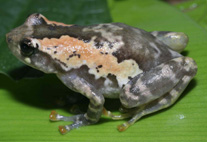Abstract
A new species of sparassocynid marsupial, Sparassocynus maimarai n. sp. from the late Miocene of Maimará Formation (Jujuy Province, Argentina) is described from a left mandibular fragment with a complete p2–m4 series. It differs from the remaining species of the genus S. bahiai (Montehermosan—late Miocene/early Pliocene—of Buenos Aires Province, Argentina) and S. derivatus (Chapadmalalan and Marplatan–Pliocene of Buenos Aires Province) by its smaller size, the relatively longer m1 with respect to the m4, the presence of a lingual cingulum extended between para- and metaconid on the m1–3, and its more robust entoconids. As part of this study the taxonomic status of Sparassocynus heterotopicus (Montehermosan, Umala, Bolivia; Pliocene) was reviewed concluding that this taxon should be referred to as ‘Sparassocynus’ heterotopicus and considered a Didelphoidea of uncertain affinities. Sparassocynus maimarai n. sp. is the oldest records of the genus, adding new information to evaluate the origins and early diversification of sparassocynids. Sparassocynus maimarai n. sp. was recovered with precise stratigraphic control, highlighting its potential biostratigraphic significance to the temporal correlations between Maimará Formation and other Mio–Pliocene stratigraphic units from the northwestern Argentina.

